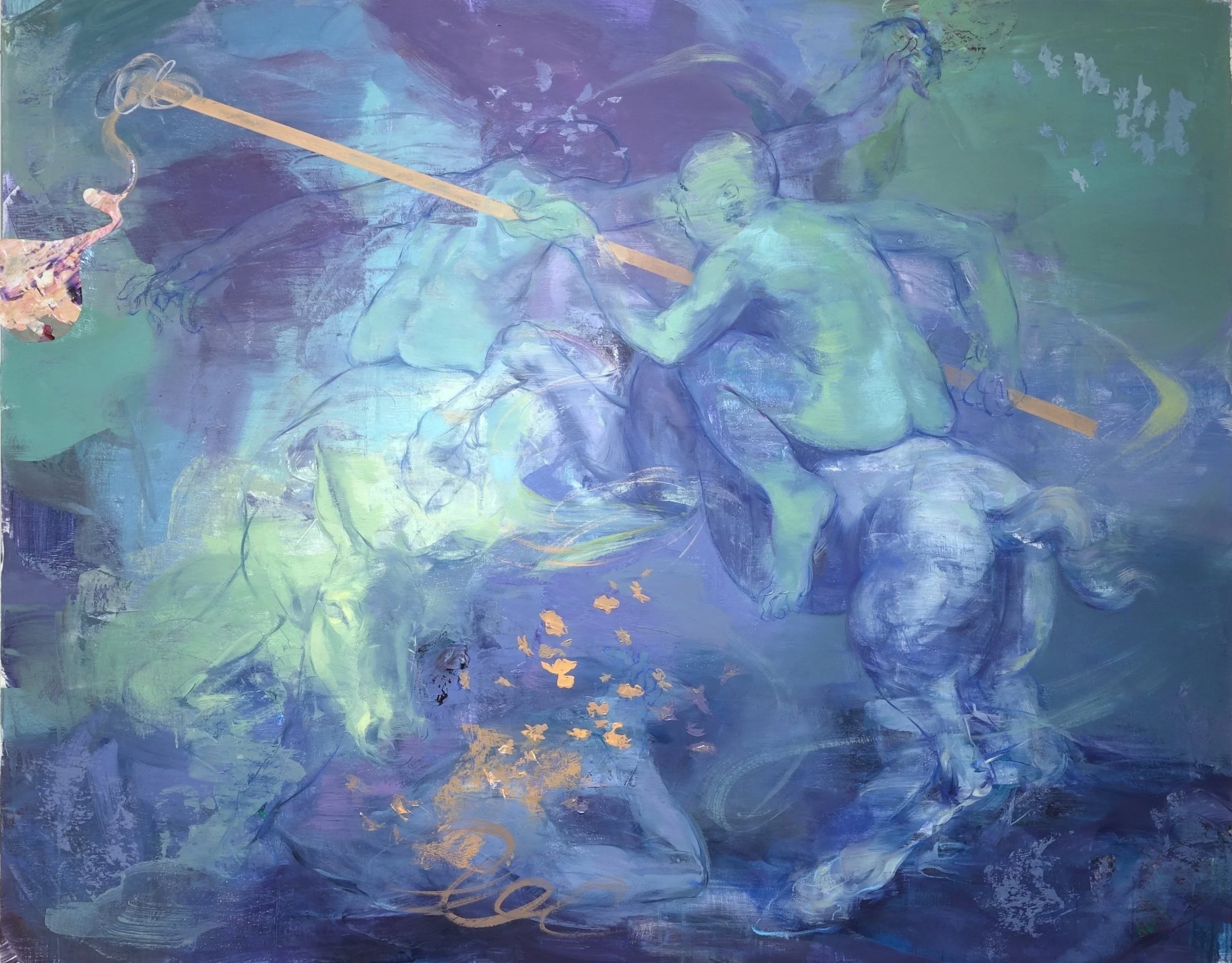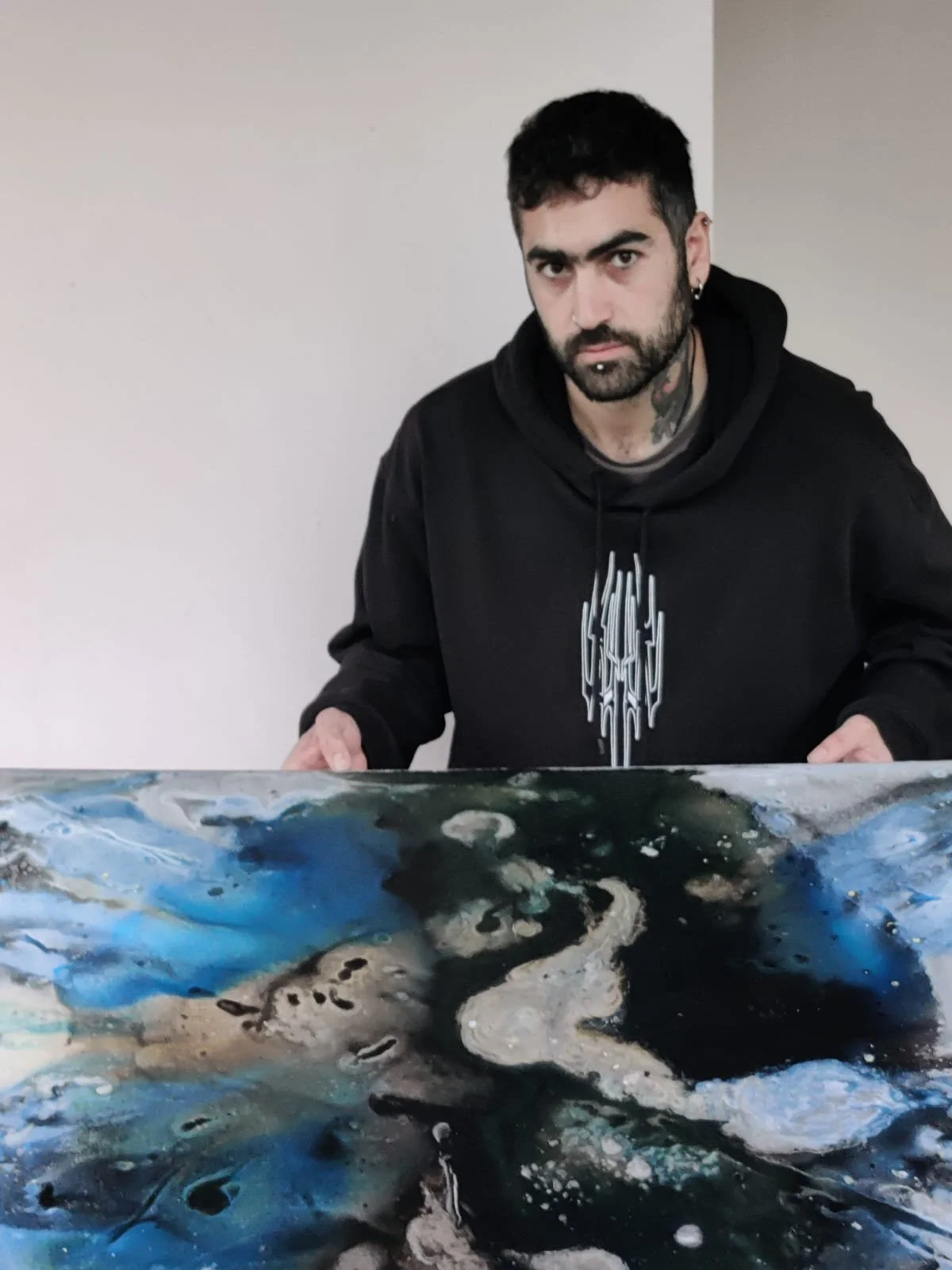10 Questions with Mahta Salehi
Al-Tiba9 Art Magazine ISSUE18 | Featured Artist
Visual artist Mahta Salehi was born and raised in Tehran, Iran. She is currently living in Tennessee and recently graduated with an M.A. in Studio Art from Eastern Illinois University. Her recent paintings investigate psychological transformation and the tension between confinement and freedom by combining abstraction and figuration and using symbolic imagery. In her work, she uses experimental techniques and layered compositions to encourage viewers to interact with the shifting nature of psychological landscapes and selfhood.
Mahta Salehi - Portrait
ARTIST STATEMENT
In her paintings, Mahta Salehi highlights identity’s fluid and ever-changing nature and investigates the tension between freedom and confinement. She is interested in the concept of individual freedom. This curiosity is the driving force behind her art, which captures the difficulties of navigating several identities and the boundaries we perceive around them—both real and imagined. Informed by recent discoveries in psychology and neuroscience, her art engages with identity as a dynamic process, shaped by the brain’s plasticity and evolving through memory, social interactions, cultural context, and environment. These influences agree with the psychological theories that identity is not fixed but is constantly reshaped by experience, a concept she brings to life through visual language. Birds, fish, and plants are some symbols she uses to represent freedom and the development that results from overcoming imagined constraints. These are contrasted with imaginary creatures wearing masks, cage-like shapes, and tree branches to create a sense of confinement and the struggle against being limited to a single, fixed identity. Her compositions are further distinguished by organic and cutout outlines that refuse rigid, traditional frameworks. These fluid, ever-growing shapes defy the convention of identity and its ever-evolving and expansive nature.
Hunting symptoms, Ink, watercolor, acrylic on paper, 16.5x23.4 in, 2024 © Mahta Salehi
AL-TIBA9 ART MAGAZINE ISSUE18
INTERVIEW
Please tell our readers a bit about your background. What inspired you to become an artist? And how did you develop into the artist you are today?
I was born and raised in Tehran, where I was exposed to various social and cultural perspectives that shaped my early understanding of the world. From an early age, art became a way for me to process and express thoughts and emotions that I could not easily articulate. Later, I studied graphic design during my undergraduate years, which gave me a strong foundation in visual communication. However, that experience also made me realize that my genuine interest lies in fine arts—specifically, creating more personal, expressive, and conceptually driven work.
How has your experience living in Tehran and Tennessee influenced your artistic perspective and the way you approach identity in your work?
I have spent most of my life in Tehran, deeply influenced by its rich cultural history and a society emphasizing collective identity and defined social roles. At the same time, I have had the opportunity to travel and briefly live in other parts of the world, including my current time in Tennessee. I think my understanding of identity has greatly changed due to these experiences—travelling to various cultural, social, and geographic contexts. Highlighting the differences between settings that prioritize individual expression and autonomy and those that place more emphasis on collective identity.
Do you see me, Ink, gouache, colored pencil on paper, 16x23 in, 2024 © Mahta Salehi
Your work explores the tension between freedom and confinement. What initially drew you to this theme, and how has your understanding of it evolved over time?
Having a fixed identity or being expected to give predetermined answers has always felt limiting to me. I have never fully understood why questions such as "What is your favourite colour?" or "What is your favourite food?" are asked, as my preferences change daily, influenced by my mood or circumstances. Being tied to a single, unchanging answer or behaviour has always felt restrictive, akin to carrying a permanent label. This tension between freedom and confinement has shaped my perspective, as I have always rejected the idea that we should be confined to one fixed version of ourselves. The ability to change, adjust, and experience life differently is central to who we are.
Your paintings blend abstraction and figuration. How do you determine the balance between the two when developing a composition?
When I begin a painting, I rarely have a fixed destination. I start with a gesture, a colour, or an emotional state and let the forms surface through layers of process and intuition. I am interested in keeping enough figuration to anchor the viewer emotionally, while abstraction provides space for interpretation and psychological depth. I aim to maintain enough representational elements to invite an emotional response. However, I also want to leave space for ambiguity—where the viewer can wander, question, and interpret. Abstraction becomes a kind of atmospheric depth, a space where the subconscious can emerge. It is not about resolving the image but allowing multiple readings to coexist within a single composition.
Psychology and neuroscience play a key role in your practice. Can you discuss a specific concept or discovery that has influenced your work?
One concept that appeals to me is neuroplasticity, the ability of the brain to change its wiring in reaction to experiences. Scientists like Michael Merzenich have explored this idea, which challenges the notion of a hard, fixed self and presents identity as fluid and constantly changing. This perspective resonates not only with how I approach form and subjectivity in my work but also aligns with psychological concepts like "narrative identity," which sees the self as an ongoing story we construct and revise, and "social constructionism," which understands identity as shaped through relationships, context, and cultural interaction. These ideas have deepened my understanding of how identity is always in motion—psychologically, socially, and scientifically.
Forgiveness and the self, Ink, watercolor on paper, 16x23 in, 2024 © Mahta Salehi
Two eyes that follow, Ink, gouache, watercolor on paper, 16x23 in, 2024 © Mahta Salehi
You use symbolic imagery, such as birds, fish, and masks, to explore identity. Are these symbols personal to you, or do they intuitively emerge as you work?
These symbols operate on both personal and intuitive levels. For instance, birds often evoke notions of freedom, elevation, or escape. However, they also carry subtle personal connections—such as the memory of hearing birds at dawn during my early years in Tehran. With their association with water and constant movement, fish suggest transformation, depth, and the unconscious. Masks represent the different versions of ourselves we present to the world in response to societal expectations and internal conflicts.
What role does experimentation play in your creative process? Are there any techniques you have experimented with that have surprised you?
Experimentation is essential to my process—it keeps the work dynamic and open to discovery. To investigate the conflict between structure and spontaneity, I frequently combine, unlike, textures and shapes such as transparent inks, watercolours, opaque gouaches, and collages. The unpredictable reactions between the materials provide space for creative reinterpretation and visual surprises.
Many of your works encourage interaction with shifting psychological landscapes. How do you hope viewers engage with your paintings emotionally or intellectually?
I hope my work creates a sense of recognition—like they see a part of themselves reflected in a way they have not before.Emotionally, I want viewers to feel the complexity of navigating identity, confinement, and transformation. Intellectually, I hope they leave with more questions than answers. I want them to wonder: Who am I beyond the labels? What limits do I accept without questioning? How much of what I call "me" is shaped by outside forces?
Find me, Ink, gouache, watercolor on paperboard, 16.5x23.5 in, 2024 © Mahta Salehi
How do you navigate the challenge of making deeply personal work while also leaving room for open interpretation?
It is always a balancing act. I start with personal emotions or memories, but I translate them through metaphor, abstraction, and symbols so that the work can speak beyond my specific story. I invite others to bring their experiences and interpretations by leaving ambiguity in the composition. Vulnerability and openness can coexist when the work is honest but not didactic.
Lastly, how do you see your work evolving within the global contemporary art scene in the coming years?
I am excited about expanding my work into more interdisciplinary spaces—possibly incorporating animation, sound, or installation to immerse the viewer fully. I also want to collaborate with people outside the art world—scientists, therapists, communities—to explore how art can be used for reflection, empathy, and connection. Within the global art scene, I hope my work contributes to ongoing conversations around identity, displacement, freedom, and the evolving human mind. I want to keep challenging boundaries, both conceptually and materially.























